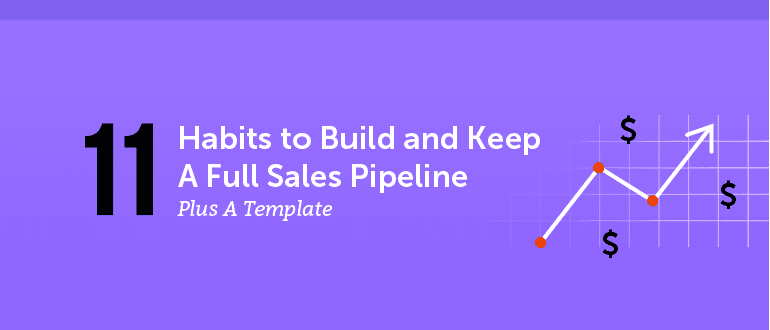
Wouldn’t it be great if your
sales pipeline automatically filled itself each month?
While that might sound like a pipe dream, it’s far from a fantasy. And you don't even need to stay late, work weekends, and give up any semblance of a personal life to make it happen.
Of course, pipelines don’t just magically fill themselves on their own.
You still have to do the work. But there are tried-and-true habits you can build, tools you can implement, and strategies you can deploy to streamline and accelerate this process to the point where it will
feel almost automatic.
To start, you’ve got to eradicate complacency, think bigger, and get hungry – not just for more sales, but for new techniques.
You’ve got to immerse yourself in
sales podcasts, books, and YouTube videos, reach out for mentorship, and seek out feedback from your colleagues and customers.
As legendary football coach
Lou Holtz once said, “In this world,
you're either growing or, you're dying, so get in motion and grow.”
Taking the time to plan out a strategy to grow your pipeline and
keep it growing might just be the best thing you do all year.
With that in mind, here are 11 habits to build to help you keep a full sales pipeline.
[Tweet “11 ways to make sure your sales pipeline is always full.”]
Download the Sales Pipeline Tracking Template
Before exploring out all the ways to keep your sales pipeline full, download the sales pipeline tracking template to make sure that you have a high-level understanding of all the deal in the pipeline and what they’re worth to your organization.
Double Down When Your Sales Pipeline is Flush
People have a tendency to slow down or let up a little when they can see the finish line.
In sales, you can’t slow down when things are going well. Any skilled salesperson will tell you to keep prospecting even when your pipeline is full. Key deals will fall through at the last minute, and if you don’t have enough of a cushion to replace them, then you’ll find yourself in a tight spot.
If you double down in the good times, you'll feel confident that you’ve got enough to make it through the month or quarter even if key deals fall through. And If those deals
don’t fall through, you've stocked your pipeline for the next month.
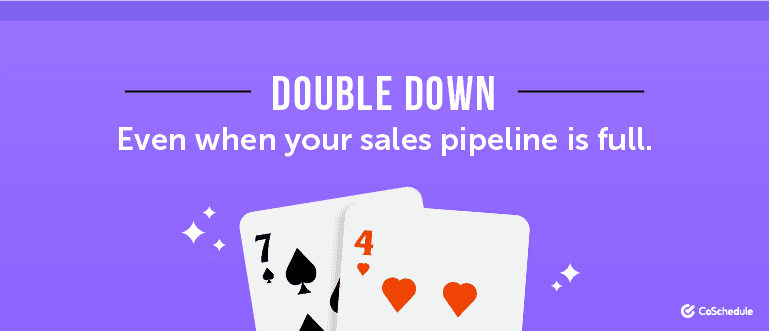
It’s also fairly common for salespeople to take time off or go easy the first day or week of the month. Instead, look at the beginning of the month as the ideal time to get a head start.
Look for buying triggers or relevant industry articles in the news, touch base with prospects, or do some LinkedIn research. Do whatever it takes to get ahead and
stay ahead. You’ll be happy you did.
Keep Testing and Tweaking Your Pipeline
The greatest salespeople know that the game is always changing: new software disrupting industries, new companies shaking things up, new technology emerging, shifts in the economy, you name it.
With that in mind, you should always be adapting to new changes and finding ways to optimize your pipeline. There is always room for improvement.
Your pitch is never perfect, your slide deck isn’t one-size-fits-all, and your sales emails won’t always be 'copy and paste'.
Julian Besonen of
Apruve recommends continually updating your information.
"I'll call customers and prospects with the persona deck in front of me to keep a clear sales pitch and to update it with new industry terms or concerns as they arise," he explains.
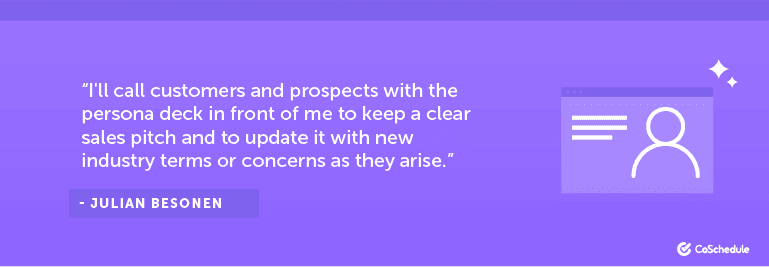
Always Hit Your Touchpoints
Every sales rep should know exactly how much activity it takes to get a lead or prospect, and how many leads it takes to close a deal.
Once you have that touch point number, you should be hitting it religiously. Rain or shine, good day or bad, hit your numbers.
While you’re at it, step up your touch points. High-growth organizations report an
average of 16 touch points per prospect within a 2-4 week span.
To make sure you don't come off as spammy,
consider an omni-channel approach where you space out touch points and use different channels. For instance, you might call one day, email the next, and connect on social media after that.
Then switch it up by liking their posts, calling at a different time of day, or sharing a different type of content.
If you can consistently hit your touch point numbers no matter the day of the month or whether or not you’ve already hit goal, you’ll be in great shape each month. Those touch points have the added benefit of getting you into a rhythm as well.
Momentum in sales can sometimes be the deciding factor between a successful month and a losing one.
Start Each Day With a Plan of Attack
Complacency is bred by meandering through your day without a set plan.
Your calendar will already have appointments and meetings on it, so fill out the rest of the day with time for
prospecting, responding to emails, admin work, and checking in on your pipeline.
In his book
The 4-Hour Work Week, best-selling author
Tim Ferriss writes, “Being busy is most often used as a guise for avoiding the few critically important but uncomfortable actions.”
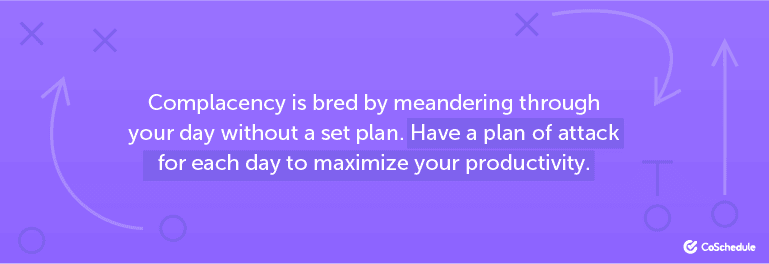
Most of us have something on our to-do list that we put off from one day to the next – that big hairy task that's hard, uncomfortable, or has a high risk of failure.
But that's usually the exact task we should be
starting our day with. Rather than dreading it all day and feeling guilty when you inevitably don’t get it done, strive to front-load your day by “
eating the frog first.”
Automate and Delegate Everything You Can
In a recent blog post,
Seth Godin writes, “In order to make that forward leap, you need to trust yourself. To create space. To have the discipline to say no to distractions or even to projects that put you back into the 1x mode.”
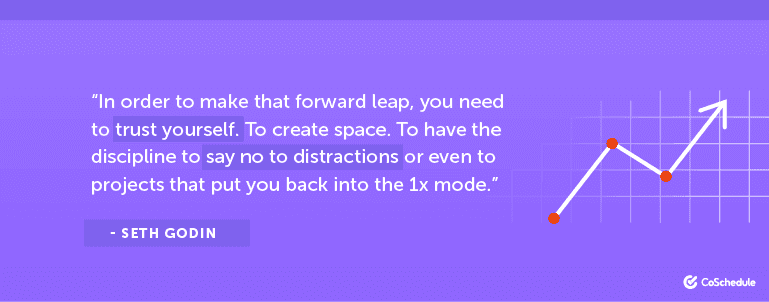
If you want to be a 10x salesperson, you have to stop doing 1x tasks.
That means automating or delegating everything you can so you can focus on closing deals – or reviving them. “Use marketing automation to bring cold deals back from the dead," suggests
webSURGE CEO
Joe Crestuk.
"Set reminders and create automated emails to reach out to prospects, 3/6 months, even a year after the deal went cold. Automation will help you prioritize warm leads without forgetting about (and losing business from) cold ones or prospects with long buying cycles."
Tap Into Referrals From Past or Current Clients
Asking for referrals takes a little finesse, but it's absolutely worth the effort. But priming the pump for referrals needs to start well before you ask for one.
In addition to providing rock-star service or high-quality products, take the time to provide a personal touch to your sales. Give customers a small gift with purchase, or include a personal handwritten note thanking them for their business and letting them know you value them.
If you
really want to level this category up, then set up some sort of
talk trigger. A phrase coined by New York Times best-selling author
Jay Baer,
talk triggers are operational differentiators that facilitate positive customer conversations about you, your product, or your company. The most effective talk triggers need to be remarkable, repeatable, realistic, and relevant for them to work properly.
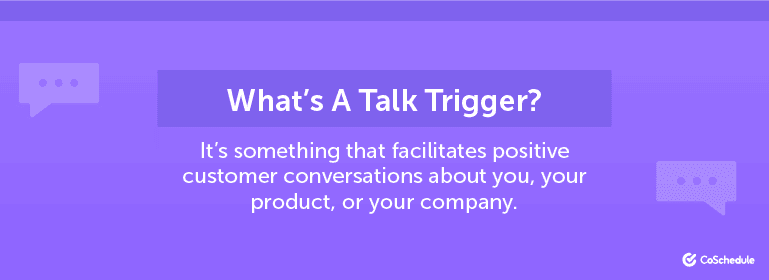
Follow up on asking for referrals just like you would a sale. Make it part of your routine. The day you close a deal, make a note on your calendar to follow up X days or weeks later to ask for a referral. Or better yet, automate the process with a tool like
Right Inbox.
Work Closely With Marketing
Jeff Previte, Content Manager at
Bluleadz, believes the role of marketing is to generate sales qualified leads for the sales team. But how often do you meet with your marketing team to make sure they understand what defines a great lead for you?
To ensure this all-too-important task doesn’t fall through the cracks, try implementing
daily scrums where sales and marketing meet for short periods to sync up activities.
Having marketing deliver qualified leads is the most effective way for you to spend more time talking to qualified prospects.
"Sales needs to be upfront about the pain points they experience at every stage while they prospect and engage with qualified leads," Previte says. "For example, prospects might benefit from marketing content, like industry-specific case studies, during the consideration stage of the buyer’s journey. Sales can speak up and request content by letting marketing know that these content demands exist.”
While you’re at it, try to encourage marketing to be more proactive in getting to know the sales process.
"One of the best ways you can encourage sales-marketing alignment is showing the marketing team what the day-to-day looks like for sales," Previte continues. "For example, invite them to sit in during discovery calls, or share email correspondence you had with prospects. This helps marketing gain a better understanding of the prospect experience and also the sales team experience, so they can better support the sales team as they move prospects through the sales cycle."
Bob Carver, Principal Strategist at
CarverTC, is also a big believer in establishing a strategic and close relationship with marketing to keep your pipeline full of quality leads.
“Working closely with marketing is one of the most effective ways for sales teams to move away from doing repetitive explanation and qualification for every new prospect that enters the funnel," he says.
"Have salespeople share with marketing how they explain the value of what they're selling, the conversations they use to qualify prospects and move them down the funnel. If marketing makes those value propositions and conversation points part of the marketing content, it will bring better leads into your funnel, salespeople will spend more time having higher value conversations, and generate more sales wins.”
Collaborate Better With CoSchedule
Sales and marketing are closely tied, but it doesn’t always seem that way due to silos.
What if both sales and marketing could easily assign tasks, share your project plans and visualize your roadmap without lengthy emails and constant check-ins?
That reality is possible.
With CoSchedule you can see and share everything your team is working on – so there is full visibility between marketing and sales.
You can fully automate your social media, plan all your projects, plan all your newsletters and sales emails, AND collaborate better.
Scale Your Sales Outreach With Effective List-building
According to
Nissar Ahamed at
Atomic Reach, one of the biggest challenges salespeople face is making their prospecting predictable and scalable. If your goal is to make X calls per day, it's difficult if you’re not equipped with a targeted list that you can rely on. To make life easier, you need to leverage
the right sales prospecting tools.
The advantage of having a polished list in your CRM is that you can focus on your outreach rather than list building. With software like
DiscoverOrg and
ZoomInfo, this has become easy.
"The marginal upfront investment of time and money will pay dividends in productivity, efficiency, and success in the long run," says Ahamed.
Grow Your Partner Network
Raul Galera at
ReferralCandy is big on growing a network you can tap into to keep your pipeline full. "Whether you’re looking into running an affiliate program with resellers, or working on co-marketing activities with other companies, partnerships are a cost-effective way to expand your presence and get in front of new potential customers," he explains.
Galera also recommends partnering with companies that:
- Don’t compete directly with your service (even better if they offer a complimentary service).
- Can also benefit from partnering with you. The only collaborations that truly work are those where both parties get something from it.
- Are happy to work with you. There are plenty of companies out there, so there's no need to work with rude, arrogant, or unenthusiastic people.
Co-branded materials such as case studies, white papers, or webinars that can be easily shared with each other's audiences are an easy way to gather new leads.
As Galera says, "Partnerships with other brands/companies can be an effective way of not only attracting new customers but also retaining existing ones and
improving their loyalty, by providing them access to new benefits and perks."
Close More Leads With Real-time Email Read Receipts
You’ve sent your outreach emails and you're sifting through responses and taking action, but what about all those opened emails that never convert?
If you're at the right scale to build out your sales team, test setting up real-time email read receipts with a tool like
Hubspot email tracking, and call prospects while they have the email open in front of them.
Those 'happy coincidences' can skyrocket conversion rates. But make sure to
A/B test and track the results, because adding this step to your outreach if you have a small team can dramatically increase your overhead.
Increase Customer Value Through Upselling
Working non-stop to attract new customers is exciting, but if you want to increase revenue without ramping up your lead generation efforts,
upselling existing customers is the easiest path for one simple reason:
trust.
With new customers, you have to build trust from square one before they’ll listen to you, let alone buy your product.
In comparison, your existing customers
already trust you. If they bought from you once, they’re much more likely to buy from you again – plus, upselling is more cost effective.
According to the
Pacific Crest SaaS Survey, which surveys hundreds of SaaS companies, “The median Customer Acquisition Cost (CAC) for upsells is just $0.28 per $1, less than a quarter of the $1.18 spent to acquire $1 of revenue from a new customer.” So take the time to regularly check in with your customers. Make them as successful as possible and identify win-win opportunities to upsell them.

The art of keeping your pipeline full is one every salesperson should strive to master.
Doing it properly has cascading effects that keep you sharp and at the top of your game. When your pipeline is full of opportunities, you aren’t tempted to resort to bad sales tactics like pressuring prospects, offering discounts, or overselling.
Instead, you'll walk into work each day with the confidence of a salesperson who knows they aren’t scraping by or settling for mediocre results.
A full pipeline allows you to sell with integrity, which means buyers will respect you more. That means more buzz, more word-of-mouth, more referrals, and in all likelihood – larger deals.
 Wouldn’t it be great if your sales pipeline automatically filled itself each month?
While that might sound like a pipe dream, it’s far from a fantasy. And you don't even need to stay late, work weekends, and give up any semblance of a personal life to make it happen.
Of course, pipelines don’t just magically fill themselves on their own.
You still have to do the work. But there are tried-and-true habits you can build, tools you can implement, and strategies you can deploy to streamline and accelerate this process to the point where it will feel almost automatic.
To start, you’ve got to eradicate complacency, think bigger, and get hungry – not just for more sales, but for new techniques.
You’ve got to immerse yourself in sales podcasts, books, and YouTube videos, reach out for mentorship, and seek out feedback from your colleagues and customers.
As legendary football coach Lou Holtz once said, “In this world, you're either growing or, you're dying, so get in motion and grow.”
Taking the time to plan out a strategy to grow your pipeline and keep it growing might just be the best thing you do all year.
With that in mind, here are 11 habits to build to help you keep a full sales pipeline.
[Tweet “11 ways to make sure your sales pipeline is always full.”]
Wouldn’t it be great if your sales pipeline automatically filled itself each month?
While that might sound like a pipe dream, it’s far from a fantasy. And you don't even need to stay late, work weekends, and give up any semblance of a personal life to make it happen.
Of course, pipelines don’t just magically fill themselves on their own.
You still have to do the work. But there are tried-and-true habits you can build, tools you can implement, and strategies you can deploy to streamline and accelerate this process to the point where it will feel almost automatic.
To start, you’ve got to eradicate complacency, think bigger, and get hungry – not just for more sales, but for new techniques.
You’ve got to immerse yourself in sales podcasts, books, and YouTube videos, reach out for mentorship, and seek out feedback from your colleagues and customers.
As legendary football coach Lou Holtz once said, “In this world, you're either growing or, you're dying, so get in motion and grow.”
Taking the time to plan out a strategy to grow your pipeline and keep it growing might just be the best thing you do all year.
With that in mind, here are 11 habits to build to help you keep a full sales pipeline.
[Tweet “11 ways to make sure your sales pipeline is always full.”]
 It’s also fairly common for salespeople to take time off or go easy the first day or week of the month. Instead, look at the beginning of the month as the ideal time to get a head start.
Look for buying triggers or relevant industry articles in the news, touch base with prospects, or do some LinkedIn research. Do whatever it takes to get ahead and stay ahead. You’ll be happy you did.
It’s also fairly common for salespeople to take time off or go easy the first day or week of the month. Instead, look at the beginning of the month as the ideal time to get a head start.
Look for buying triggers or relevant industry articles in the news, touch base with prospects, or do some LinkedIn research. Do whatever it takes to get ahead and stay ahead. You’ll be happy you did.

 Most of us have something on our to-do list that we put off from one day to the next – that big hairy task that's hard, uncomfortable, or has a high risk of failure.
But that's usually the exact task we should be starting our day with. Rather than dreading it all day and feeling guilty when you inevitably don’t get it done, strive to front-load your day by “eating the frog first.”
Most of us have something on our to-do list that we put off from one day to the next – that big hairy task that's hard, uncomfortable, or has a high risk of failure.
But that's usually the exact task we should be starting our day with. Rather than dreading it all day and feeling guilty when you inevitably don’t get it done, strive to front-load your day by “eating the frog first.”
 If you want to be a 10x salesperson, you have to stop doing 1x tasks.
That means automating or delegating everything you can so you can focus on closing deals – or reviving them. “Use marketing automation to bring cold deals back from the dead," suggests webSURGE CEO Joe Crestuk.
"Set reminders and create automated emails to reach out to prospects, 3/6 months, even a year after the deal went cold. Automation will help you prioritize warm leads without forgetting about (and losing business from) cold ones or prospects with long buying cycles."
If you want to be a 10x salesperson, you have to stop doing 1x tasks.
That means automating or delegating everything you can so you can focus on closing deals – or reviving them. “Use marketing automation to bring cold deals back from the dead," suggests webSURGE CEO Joe Crestuk.
"Set reminders and create automated emails to reach out to prospects, 3/6 months, even a year after the deal went cold. Automation will help you prioritize warm leads without forgetting about (and losing business from) cold ones or prospects with long buying cycles."
 Follow up on asking for referrals just like you would a sale. Make it part of your routine. The day you close a deal, make a note on your calendar to follow up X days or weeks later to ask for a referral. Or better yet, automate the process with a tool like Right Inbox.
Follow up on asking for referrals just like you would a sale. Make it part of your routine. The day you close a deal, make a note on your calendar to follow up X days or weeks later to ask for a referral. Or better yet, automate the process with a tool like Right Inbox.
 The art of keeping your pipeline full is one every salesperson should strive to master.
Doing it properly has cascading effects that keep you sharp and at the top of your game. When your pipeline is full of opportunities, you aren’t tempted to resort to bad sales tactics like pressuring prospects, offering discounts, or overselling.
Instead, you'll walk into work each day with the confidence of a salesperson who knows they aren’t scraping by or settling for mediocre results.
A full pipeline allows you to sell with integrity, which means buyers will respect you more. That means more buzz, more word-of-mouth, more referrals, and in all likelihood – larger deals.
The art of keeping your pipeline full is one every salesperson should strive to master.
Doing it properly has cascading effects that keep you sharp and at the top of your game. When your pipeline is full of opportunities, you aren’t tempted to resort to bad sales tactics like pressuring prospects, offering discounts, or overselling.
Instead, you'll walk into work each day with the confidence of a salesperson who knows they aren’t scraping by or settling for mediocre results.
A full pipeline allows you to sell with integrity, which means buyers will respect you more. That means more buzz, more word-of-mouth, more referrals, and in all likelihood – larger deals.

